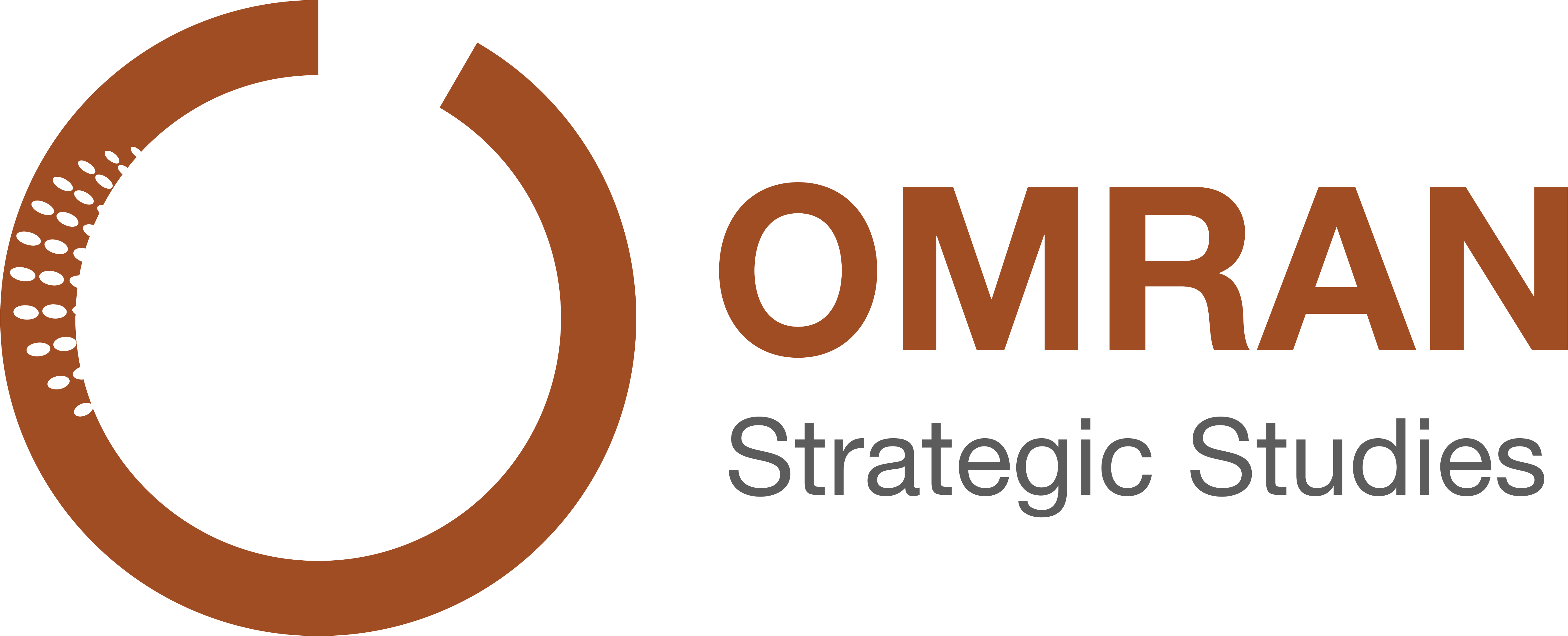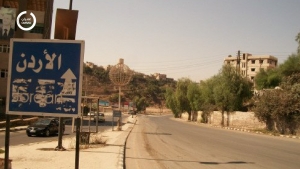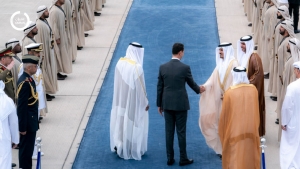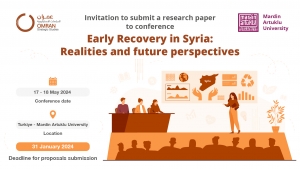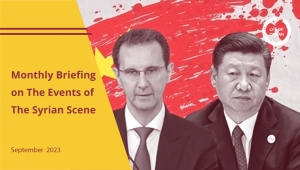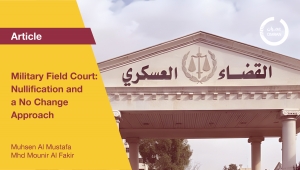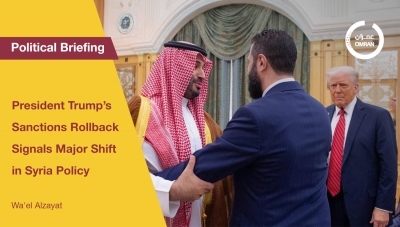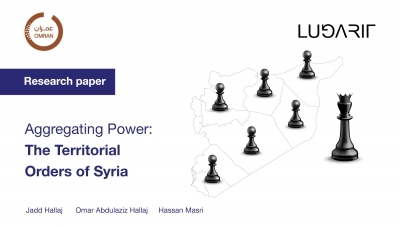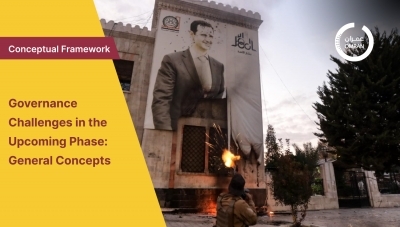Omran News
Omran Studies
From Settlement to Captagon: The Security Dynamics in Syria’s Daraa
The Captagon problem has been one of the most critical security dilemmas for Jordan, due to the increasing attempts of drug and weapon trafficking into its borders that became a threat to Jordan’s national security according to a formal assessment paper, along with the ineffectiveness of the current mechanisms to deter the actors involved in Captagon, particularly Iran-backed militias and the Syrian regime. Although the 2017 de-escalation agreement is supposed to grant Iran-backed militias being pushed back 40 km from the Jordanian border, Russia has not completely fulfilled its pledges. The Russian-sponsored settlements of 2018 and 2021 have failed to introduce a security-providing environment through the DDR process of opposition armed groups in Syria’s Daraa.
The security dynamics of the settlements have played a crucial role in creating a Captagon-friendly environment i.e. the absence of a hegemon actor with the involvement of Russia, Iran, and the regime, in addition to former opposition groups which underwent a transformation process in terms of their motivations (political or economic) and objectives of the use of force (zero-sum or variable-sum). Many of the armed groups that had fought fiercely against the Syrian regime gave up on their political aspiration and became involved in Captagon trafficking. This article provides insight into the security landscape, particularly the interconnection between security and Captagon, as a war economy dynamic, in Syria’s Daraa, and ultimately proposes alternative policy scenarios.
The Status Quo of the Settlements
The settlements of 2018 and 2021 between the Syrian regime and opposition factions under Russian auspices resulted, mainly, in the piecemeal return of the regime’s security apparatuses to the governorate, and the integration of many opposition fighters into these apparatuses, without achieving concrete progress vis-a-vis the detainees or forcibly-disappeared persons in regime’s prisons. Since the first settlement, Daraa has been characterized by a fragile security with the prevailing wide scale, politically motivated to a large extent, violence against various civil and armed individuals, let them be affiliated with the opposition or the regime.
Assassinations and detentions, at which dozens of individuals are targeted monthly, have been the regime’s tools to eliminate his opponents relying, for the most part, on the Military Intelligence Branch of Daraa/Swayda, led by “Loay al-Ali”– an EU, UK, and Canada sanctioned Brigadier-General who was promoted to his current position before the 2018 settlement after he served head of the military intelligence/Daraa section between 2011 and 2018.
Thus, the regime rested on a variable-sum use of force to strengthen its territorial control, eliminate opponents, benefit economically from Captagon trafficking, and underpin its central role in the settlement status quo. Yet, even the transformation of regime behavior from zero-sum to variable-sum is mainly a result of Russian diplomatic coercion and the externally imposed status quo in Syria i.e. the relatively frozen conflict that started to arise in 2018.
The Transformation of the Opposition Armed Groups
Former opposition armed groups in Daraa have pursued different survival strategies to cope with or counter-balance the increasing security leverage of the regime in the governorate. Their transformations have generated different types of armed groups with varying motivations and objectives. While the 8th brigade became mainly motivated by preserving the settlement’s status quo that granted the brigade territorial control over some localities and a maneuvering ability to expand influence; other groups, many of which became associated with the regime, have relinquished their political motivations for economic ones through getting involved in Captagon trafficking and/or thuggery activities.
The 8th brigade led by the former opposition commander, Ahmed al-Oda, and composed mainly of former opposition fighters of “Sunna Youth Forces,” has maintained its territorial control in Eastern Daraa’s Busra al-Sham since its establishment under Russian auspices in the aftermath of the first settlement in 2018. Given the relatively secure environment with the lowest assassination rate and the better governance services in areas under its control in comparison with other areas in Daraa, the brigade has managed to preserve social support and counterbalance the regime’s influence seeking to preserve the settlement status quo. Yet, the brigade increased its leverage through variable-sum use of force.
The 8th brigade conducted multiple security operations against ISIS or groups accused of ISIS affiliation in different parts of Daraa such as Jasim in Western Daraa in August 2022 and Daraa al-Balad neighborhood where the operation eliminated the Hafo-Harfoush militia in December 2022. These operations were conducted after the regime’s escalation and threats to launch offensives in these areas under the pretext of ISIS cells, in which the 8th brigade capitalized on the social rejection of the regime’s interference and its connections with local Sheikhs and dignitaries. In addition to its previous intermediary role between the regime and local communities to ease escalation such as the cases of the 2022 March escalation in Jasim and the 2020 February escalation in al-Sanamayn city Northwestern Daraa. Moreover, the 8th brigade has also targeted other groups involved in Captagon trafficking in Northeastern Daraa including a group affiliated with Fayez al-Radi, a former opposition commander assassinated after an escalation with the 8th brigade.
Other groups such as those led by Mustafa al-Masalmeh and Imad Abu Zureiq, the two former opposition commanders, have not only given up their political struggle against the regime after the settlement but also became affiliated with the regime, as they became motivated by economic motives under the new status quo, where the regime became superior. As such, they have been involved in trafficking Captagon drugs, imposing levies on locals, and conducting assassinations against regime opponents on behalf of the military intelligence – which is managing militias and receiving levies from them.
By April 2023, both Abu Zureiq and al-Masalmeh were sanctioned, along with Assad family-affiliated individuals including his cousins, by the U.S., EU, and UK for their involvement in the production and export of the Captagon. However, al-Masalmeh was later killed after several attempts on his life by local factions due to his involvement in assassinating numerous opponents of the regime.
Hafo-Harfoush militia is another armed group led by two former opposition commanders Muhammad al-Masalmeh and Moayad Abdel-Rahman who -unlike other opposition groups- rejected the settlements and refused to be displaced to Northern Syria. They were, territorially, located in Daraa al-Balad neighborhoods until getting defeated by local factions supported by the 8th brigade in November 2022, for their links to ISIS cells, implication in assassinations against opposition figures based on revenge motives, and involvement in thuggery activities such as theft and imposing levies on locals. All of these security dynamics illustrate the overlap of security and war economy, notably the Captagon trade.
Alternative Policies: Addressing the Captagon Dilemma
Sanctions have not been effective in impelling the regime to make concrete concessions or changes such as in the case of the military intelligence in Daraa and similarly had no impact on the former opposition commanders, currently affiliated with the regime. The Arab engagement with the Syrian regime has not only failed to make progress in countering the Captagon trafficking, but the trafficking itself also increased after the normalization talks that led to the regime’s return to the Arab League in May, let alone the increasing technological capabilities of drug traffickers such as the use of drones.
For regional policy implication: First, Jordanian national security should be considered vital for regional security by Jordan’s international and Arab allies against the Iranian aspiration for a next domino after Lebanon, Iraq, Yemen, and Syria. Second, the assumption that the Syrian regime possesses the willingness and/or the capacity to counter the Captagon problem or disassociate from Iran should be reconsidered. Third, policy options should account for the interconnection of regime-affiliated security actors and Captagon trafficking, and the increasing capabilities of Captagon networks. The May statement by the Jordanian foreign minister on the prospect of taking military action to counter the Captagon threat in Syria and the three Jordanian airstrikes targeting drug smugglers and factories in May, August, and December, highlight an alternative policy based on coercive means that can and should be adopted in countering drug trafficking.
Given the lack of a comprehensive solution, three alternative policy scenarios can be illustrated:
- Strengthening state institutions: The interconnection between the regime and the smuggling networks, its use of the Captagon as a weapon, and the current inability to enforce security sector reform on the regime render the latter unreliable in countering the Captagon.
- Proactive targeting of Captagon networks: The Jordanian previous airstrikes were reactive in nature and limited in scale. A proactive strategy shall, rather, be focused on targeting the factories operating in different locations across Syria as well as the Captagon barons. Such a strategy requires U.S. and regional support in addition to coordination with Russia.
- Buffer zone: A demilitarization process in Southern Syria that necessarily requires a new status quo i.e. a new agreement with Russia and a new settlement that involves demilitarization. Such a scenario would prevent a potential spillover of the Gaza war to Southern Syria – which is, perhaps, in the interest of all parties involved. However, the technical challenges in enforcing and monitoring such settlement will not be easy to deal with.
Finally, the dynamics of the settlement in Daraa, its security repercussions, and its interconnection with the war economy can no longer be ignored, especially with the outstanding risk of spillover into the neighboring Sweida that has been gripped by a state of unrest since August.
The Source : Politics and Society Institute
Article link: https://bit.ly/3GZZjSc
Gaza War: The Responses of Syria’s Local Actors
Given Syria's involvement in the Arab-Israeli conflict since 1948, solidarity with Palestine has been a fundamental element within Syria's political culture. Regarding Syria's local actors’ stances on Gaza war (Syrian regime, Syrian opposition, “Hayat Tahrir al-Sham”, and “Syrian Democratic Forces”), while there is consensus in expressing solidarity with the Palestinian people in Gaza, their approaches to the war varied significantly in respective to their stances on Hamas, the “al-Aqsa flood” operation, and how they used the war in their different political strategies. These differences stemmed from a blend of ideological political identities on one hand and objective considerations related to their different relations with international and regional actors on the other. This article provides insight into the discourse projected by these actors on Gaza.
The Syrian regime has consistently propagated a narrative of resistance since the onset of the Gaza war, publishing official statements through its foreign ministry or speeches delivered by its prominent figures, notably Bashar al-Assad and his Foreign Minister, Faisal Mekdad. The regime praised the “al-Aqsa flood” operation as a “glorious achievement,” linking it to the October 1973 war due to its historical significance as a victory within the Syrian and Arab narrative.
Using the Gaza war in emotional mobilization of its popular incubator and its narrative of conspiracy, the regime associated the Israeli aggression with the ongoing struggle in Syria, holding Israel accountable for supporting the perpetrators of the drone attack on the Homs Military Academy on October 5th. This sentiment was further underscored by Mekdad when he criticized the stances of the United States and European states on Gaza accusing them of “Western deceit and open appetite for killing Arabs, including Palestinians.” In response to Israeli escalation of targeting various Iranian and regime sites in Syria, the regime continued to propagate a discourse centered on the right to defend sovereignty and reclaiming the Golan Heights within the 1967 borders.
By political means, the Syrian regime leveraged the regional atmosphere after the Gaza war to bolster its diplomatic activity within the Arab League and its bilateral diplomatic engagement with various Arab countries. While Assad advocated for halting the process of Arab-Israeli normalization during the extraordinary joint Arab Islamic summit on Gaza in November, the regime did not record formal reservation on any of the summit's resolution provisions, including having “normal relations with Israel,” a reservation upheld by Algeria, Iraq, and Tunisia (1).
This reflects the regime's alignment with the official and prominent Arab stance concerning the Israeli aggression on Gaza in formal diplomatic means, while concurrently maintaining a vehement anti-Israeli and anti-Western sentiment through its rhetoric, as a cornerstone of the “axis of resistance” led by Iran.
“Hayat Tahrir al-Sham” adopted a different narrative toward the “al-Aqsa flood” operation in comparison to jihadist groups - al-Qaeda and its branches - that advocated in their statements for jihad and targeting Western sites in Muslim countries. HTS's official rhetoric, expressed through statements by its “Syrian Salvation Government,” revolved around praising the operation carried out by Hamas, endorsing the Palestinian people's right of “the entire liberation of Palestinian land,” and calling on the “international community and Arab nations” to halt the Israeli aggression on Gaza after the Israeli targeting of Jabalia refugee camp. HTS’s call, in essence, mirrored a statement issued earlier by the Taliban government, which has been promoted as a “model” by prominent figures within HTS.
As it has been promoting itself as a moderate actor, the SSG’s Ministry of Media issued -ironically- a statement on press freedom and condemned the Israeli targeting of journalists regardless of their faith. This condemnation included Israeli violations of the targeting of journalist Wael al-Dahouh's family, the killing of journalist Sherin Abu Akel in Palestine, and the targeting of journalist Carmen Joukhadar in Lebanon.
At the same time, the jihadist element remained present in the speeches of HTS figures, notably Abdul Rahim Atoun, the head of its Fatwa Council. He said that the conflicts in both Syria and Palestine constitute a jihad that is an "obligation" upon every Muslim. This declaration was made during a symposium titled "From Idlib to Gaza... One Wound," organized by the SSG’s Ministry of Media. This highlights the tone difference in the technical statements and media discourses as well as the continuation of the jihadist ideological element within HTS's narrative.
Nevertheless, the primary objective of the symposium was to draw parallels between the Palestinian resistance against Israel and the Syrian struggle against the regime. The focus was on highlighting the similarities in crimes committed against the Syrian and Palestinian people, by the Assad regime and Israel respectively. This narrative resonated with SSG’s official statement, which regarded Palestinian resistance as an inspiring model for the struggle against the Syrian regime. A narrative aligns with HTS's efforts to project a national-Islamist image at the expense of its former Jihadist one.
As for the Syrian Opposition, the Syrian Negotiation Commission, the Syrian National Coalition, and the Syrian Interim Government expressed solidarity with Gaza, particularly following the bombing of al-Maamadani Hospital. Both the statements from the Negotiations Committee and the National Coalition condemned the crimes committed by Israel and emphasized the significance of the Arab Peace Initiative (2002), rejecting the forced displacement of Gaza residents. Simultaneously, the Interim Government condemned the crimes of the Israeli occupation and declared a three-day national mourning in its controlled areas.
Regarding their stance on Hamas or “al-Aqsa flood,” there hasn’t been any official statement or position issued on the matters, given the challenge of attaining a unified stance within the opposition due to the varying and sometimes conflicting positions toward Hamas, driven by ideological or political reasons related to Hamas's stance on the Syrian regime or Iran. Let alone the objective considerations related to the opposition’s political relations with international and regional actors.
As for the “Syrian Democratic Forces,” the SDF-affiliated “Syrian Democratic Council,” issued a statement condemning the targeting of civilians in Gaza, particularly the al-Maamadani Hospital, taking into consideration the pro-Palestinian sentiment among Syrians. The statement made reference to the “right of the Palestinian people to self-determination,” in line with SDF’s claim of the “Autonomous Administration” in Northeastern Syria. On Hamas, the head of the SDF, Mazlum Kobane, condemned it, yet expressed concerns over the Israeli objective to eradicate Hamas because of the potential spillover effects of such eradication.
The response of local actors in Syria to the Gaza conflict varied significantly in their level of engagement, political stances, and the use of the war in their narratives. There has been notable and active engagement by the regime and HTS, moderate engagement from the opposition, and cautious one from the SDF. The regime leveraged the Gaza war in emotional mobilization within its popular incubator as a cornerstone of the resistance axis by endorsing Hamas. Simultaneously, the regime has politically capitalized on the regional atmosphere to strengthen its diplomatic presence within Arab politics. HTS has also used the war in emotional mobilization in Idlib and in its rebranding process as a local actor endorsing Hamas as a model. In contrast, the opposition limited its response to humanitarian solidarity with Gaza, refraining from issuing an official stance on Hamas. The SDF pursued minimal engagement with Gaza and was the only actor to take an anti-Hamas stance along with fearing the repercussions of the war.
Finally, the result of the war on Gaza, will have impact on these actors, particularly for HTS and SDF, at least in terms of boosting their confidence to survive as semi-state actors in case Hamas survives the Israeli military campaign or diminishing that confidence in case Israel manage to eradicate Hamas.
([1]) This stance followed the regime's prior formal reservation on “any wording that could be interpreted to equalize between the Israeli occupier and the Palestinian people living under occupation,” in the resolution of the extraordinary ministerial session of the Arab League on Gaza in October, akin to reservations expressed by Iraq, Libya, Algeria, as well as Tunisia which objected to the resolution entirely, advocating for “the right of the Palestinian people to establish their independent state on all of the territory of Palestine.”
Monthly Briefing on the Events of the Syrian Scene November 2023
General Summary
This report provides an overview of the key events in Syria during the month of November 2023, focusing on political, security, and economic developments. It examines the developments at different levels.
- Politically, the political stance of Assad's regime towards the Israeli aggression on Gaza was aligned with Iran's approach of non-escalation and was consistent with the prevailing Arab official stance, attempting to use the event to increase interaction with the Arab and regional surroundings. However, the issuance of a French arrest warrant against Bashar al-Assad and other officials may negatively impact Assad's efforts to break his diplomatic isolation.
- Security, the ongoing war in Gaza cast its shadow over the security situation in Syria. Israel intensified its airstrikes against various military and logistical sites, notably the Damascus and Aleppo airports, which were put out of service again, while Iran-backed militias continue to expand their influence and move their forces to Syria's southern borders.
- Economically, inflation rates rose by over 800% in the last quarter of this year. The regime's government began exporting citrus crops from the coastal region to Iraq, marking a first-of-its-kind step between the two countries. The Chinese government also plans to provide support to the regime in telecommunications and solar energy.
Syrian Political Landscape: Assad's Diplomatic Maneuvers and Opposition Movements
Bashar al-Assad attended the Arab summit held in Saudi Arabia's capital. During his address, he denounced the Israeli aggression in Gaza, calling for an immediate halt to these acts and the facilitation of urgent aid to Gaza. Assad engaged in bilateral discussions at the summit with the leaders of Iraq, Egypt, Iran, and Mauritania seeking to mend ties with Arab and Islamic nations to alleviate his diplomatic seclusion and attempt to shift focus from his own human rights violations in Syria.
Simultaneously, Prime Minister “Hussein Arnous's” participation in the World Climate Summit in the UAE showcases the regime's keenness to engage in global forums, aiming to reintegrate into the international community and alleviate economic sanctions.
However, this diplomatic outreach coincides with a French arrest warrant issued against Bashar al-Assad, Maher al-Assad, and other Syrian officials, signifying a new chapter in the pursuit of justice for war crimes. This development poses a potential setback to Assad's diplomatic re-engagement efforts.
Domestically, Bashar al-Assad issued Legislative Decree No. 36 of 2023, offering a general amnesty for crimes committed before November 16, 2023. This move, not the first of its kind, seems to be an attempt to placate Arab and Western governments demanding such actions, and to reinforce the regime's stance on Arab initiatives for resolving the Syrian conflict. However, statistics show that less than 5% of opposition detainees have benefited from such amnesties, leaving over /135,000/ detainees still incarcerated since the revolution.
On the Syrian Opposition front, there has been a notable increase in meetings with envoys from various countries and international entities, with a focus on humanitarian issues and calls for enhanced European support, particularly in education. Key meetings include:
- The Syrian Negotiating Commission (SNC) Chairman met with the U.S. Deputy Assistant Secretary of State.
- The SNC delegation met with envoys from the USA, UK, France, Germany, the Netherlands, Switzerland, EU, Turkey, Italy, Denmark, Canada, Egypt, Qatar, and UN envoy Geir Pedersen in Geneva.
- The National Coalition of Syrian met with the Dutch Ministry of Foreign Affairs delegation in Istanbul.
Israeli Strikes in Syria: A Strategic Overview
Since the beginning of the Israeli aggression in Gaza, there have been about /23/ Israeli strikes targeting various locations in Syria, including /9/ strikes in November across the Damascus countryside, Daraa, and Homs. A notable strike was at Damascus International Airport, causing a temporary shutdown. Concurrently, Russia permitted Iranian flights from Tehran to land at the Khmeimim Air Base, as Damascus and Aleppo international airports were inaccessible. Additionally, these strikes hit air defense systems at Mezzeh military airport.The Israeli strikes were executed for several reasons:
- Retaliation against unidentified shelling from Daraa's countryside towards the occupied Golan Heights.
- Intent to impede the movement of Iranian officials into Syria.
- To deter the Syrian regime and Iran from escalating the conflict with Israel.
In Southern Syria, Iranian militias have expanded control near the occupied Golan border, transferring fighters from the Iraqi Popular Mobilization Units (PMU) and local militias from Deir Ezzor to the southern frontlines, meanwhile the regime's recent arrest campaign in southern Syria neutralized Russian-affiliated military personal, expanding by that the security gab in the southern region, while will allow Iran’s militia to expand and in increase its presence over there, posing a constant threat and serving as a leverage tool against the international community concerning Tehran's nuclear program and support for the Assad Regime.
In North-Eastern Syria, to secure the Syrian-Turkish border, prevent PKK infiltration, and combat drug and human trafficking, the Ministry of Defense of the Syrian Interim Government deployed 3,000 Syrian National Army members in border guard brigades. The National Liberation Front in Idlib province merged with smaller factions, reducing their number for more effective ground forces.
In Eastern Syria, “Tribal Forces” attacked Syrian Democratic Forces (SDF) positions in Deir Ezzor's eastern countryside. Turkish drones also conducted air raids in Hasakah province, resulting in casualties among the SDF.
Amid the global preoccupation with the war in Gaza, and in order to achieve field gains for the benefit of Assad's regime, Russian warplanes conducted several raids in different regions in Syria:
- /30/ raids in Idlib and Hama countryside targeting Hay'at Tahrir al-Sham and Ansar al-Tawhid, and supply lines in the al-Ghab Plain, claiming to target a drone depot in Idlib. HTS conducted /64/ operations against the regime, resulting in nearly /30/ fatalities among the Regime fighters.
- /60/ raids against ISIS hidden cells areas of presence in Hama desert, Homs, Deir Ezzor, and Raqqa, killing /13/ ISIS members. Meanwhile, in response to the 17’s ISIS cells recent attacks in Homs, Deir Ezzor, Raqqa, and Aleppo, causing /73/ fatalities, predominantly regime forces.
Syrian Economic Turmoil: Central Bank Struggles, Regional Partnerships, and Local Challenges
In the Regime Held-Areas, The Central Bank of Syria has been continuously floating the Syrian Pound's (SYP) value against foreign currencies, devaluing it by over 300% since the start of the year. The Syrian Pound’s recent valuation stands at /12,600/ SYO against the U.S. $, covering both cash exchange and foreign transfers. This strategy reflects the Central Bank's struggle against foreign exchange shortages, funding scarcities, and the challenge of combating the black market. This devaluation is a sign of the Central Bank's inability to stabilize prices, with inflation in Syria soaring to 800% in the last quarter of 2023. This dramatic inflation is attributed to the regime's diversion of resources to the military, production paralysis, scarcity of commodities, and international sanctions.
In a move to bypass sanctions and strengthen banking and trade relations, the Governor of the Central Bank of Iran, “Mohammad Reza Farzin”, visited Damascus. Both nations agreed to use local currencies in trade and establish communication channels between their central banks. Iran also plans to open its first bank in Syria soon.
Following Bashar al-Assad's visit to China, the Chinese government intends to support Syria in communications and solar energy, including expanding maritime digital transport equipment in Tartus and enhancing the international gateway.
Simultaneously, the Syrian regime is working to enhance economic relations with neighboring and allied countries. This includes updating a 1969 air transport services agreement with Iraq and initiating citrus fruit exports from Syria's Sahel region to Iraq, a first between the two countries.
In Latakia, the Farmers' Union warns of the potential extinction of cattle breeding due to soaring production costs, especially for fodder. Dairy and cheese prices have escalated, and the regime has increased fertilizer prices by about 200%, leading to higher food product prices. The meat market is also affected, with chicken prices in Homs governorate hitting /35,000/ SYP per kilo, leading to the closure of 75% of poultry farms due to financial losses.
As food and other product prices rise, the regime government has increased the cost of “unsubsidized” bread by over 100%.
In the SDF Held-Areas, transportation fares between northeastern Syrian cities and towns have been raised by 25% for the second time in two months.
Farmers in Deir Ezzor's eastern countryside face agricultural production challenges due to water scarcity and the Administration's failure to provide irrigation water and fuel distribution, threatening the effectiveness of land cultivation.
In the Opposition Held-Areas, the Ministry of Agriculture of the Syrian Interim Government launched a wheat crop support project in Aleppo's countryside, aiming to cultivate /2,000/ hectares with the support of the Trust Fund for the Reconstruction of Syria. The project encompasses several cities and towns, including al-Ghandoura, al-Rai, Bza'a, Marea and Azaz
Additionally, a 2-million-euro solar energy project for drinking water pumping stations was inaugurated in al-Bab city, funded by the Syria Recovery Trust Fund. This project, the largest of its kind in northern Syria, will serve 200,000 people with 2547 solar panels. Lastly, the “Sakan Foundation” continues its “Safe Haven” project in Kafr Taanour village, constructing /400/ residential houses for /2,396/ beneficiaries.
An invitation to submit a research paper to the second research conference of Omran Center titled: Early Recovery in Syria: Realities and Future Perspectives
Early recovery in Syria stands out as one of the most significant variables that has started to take shape in recent years. There are indications of varying dynamics in early recovery in the current areas of influence, which are distinct in terms of local actors, needs, resources, and capabilities, as well as variations in local, regional, and international approaches to this variable. In this context, the Omran Center for Strategic Studies, in collaboration with Mardin Artuklu University, is organizing its second research conference titled “Early Recovery in Syria: Realities and Future Perspectives”.
Therefore, we announce the commencement of receiving research proposals for participation in the conference in Arabic, English and Turkish. The deadline for submitting research proposals is January 31, 2023.
The conference is scheduled for May 17-18, 2024.
For more details:
- Main Themes and Subscription Criteria: https://bit.ly/47N6clq
- Conference Background Paper: https://bit.ly/47Jap9A
- Submission Link: https://bit.ly/3Gf1rFg
Monthly Briefing on the Events of the Syrian Scene October 2023
General Summary
This report provides an overview of the key events in Syria during the month of October 2023, focusing on political, security, and economic developments. It examines the developments at different levels.
- Politically, the political scene in Syria was affected by the Israeli aggression on Gaza, and the residents of as-Suwayda continued their weekly demonstration on Fridays, demanding political transition and reforms.
- Militarily, A drone strike hit Homs' military college, killing /123/, as reported by regime media. In retaliation, the regime bombed Idlib and Aleppo's outskirts. Concurrently, Turkey launched airstrikes on Syrian Democratic Forces “SDF” leaders following a PKK-claimed September attack in Ankara. Amidst Israeli strikes on Gaza, US bases in Eastern Syria saw over /18/ Iranian-backed militia attacks, with Israel also targeting Syrian airports in Aleppo and Damascus.
- Economically, Syria's regime revealed a 2024 budget 114% higher than the last, signaling ongoing deficit spending and rising poverty. Moves to float the Syrian pound and cut private sector support were marked by currency devaluation and updated bi-weekly fuel prices.
The Israeli-Gaza Conflict Impacts on Syria and the Homs Military Academy Explosion's Aftermath
In the Regime Held-Areas
The escalating tensions in Gaza have markedly impacted regional dynamics, prompting:
- Over /30/ attacks by Iranian-backed militias on US bases across Syria and Iraq.
- 2Increase in Israeli airstrikes targeting Syrian Regime facilities.
Key sites such as the US's al-Tanf base, al-Omar oil field, and the al-Shadadi base have been subjected to intensified UAV and rocket attacks by these militias. Additionally, the Koniko gas pipeline, the American base in “Rubarba” near al-Malikiyah, and the “Kharab” base have sustained damage from these attacks.
Beginning October 7th, Israel escalated its military actions against Syrian Regime and Iranian-backed militia targets, executing over nine strikes in different areas. Significantly, Israel targeted Aleppo International Airport four times, Damascus International Airport twice, and four military locations in Daraa. These strikes in October represent a strategic shift, aiming to:
- Preventing Iranian Influence: Israel's efforts to prevent Iranian militias from strengthening their positions in Southern Syria, especially following the events in Gaza, suggest a proactive approach to counter what it perceives as a growing Iranian influence in the region. This is in line with Israel's long-standing policy of countering Iranian expansion and influence in neighboring countries.
- Demonstrating Military Readiness and Capability: The nature of these strikes, notably their scope and precision, serves as a demonstration of Israel's military readiness and capability to operate on various fronts. This could be intended as a deterrent to potential aggressors and a show of strength to both regional and international audiences.
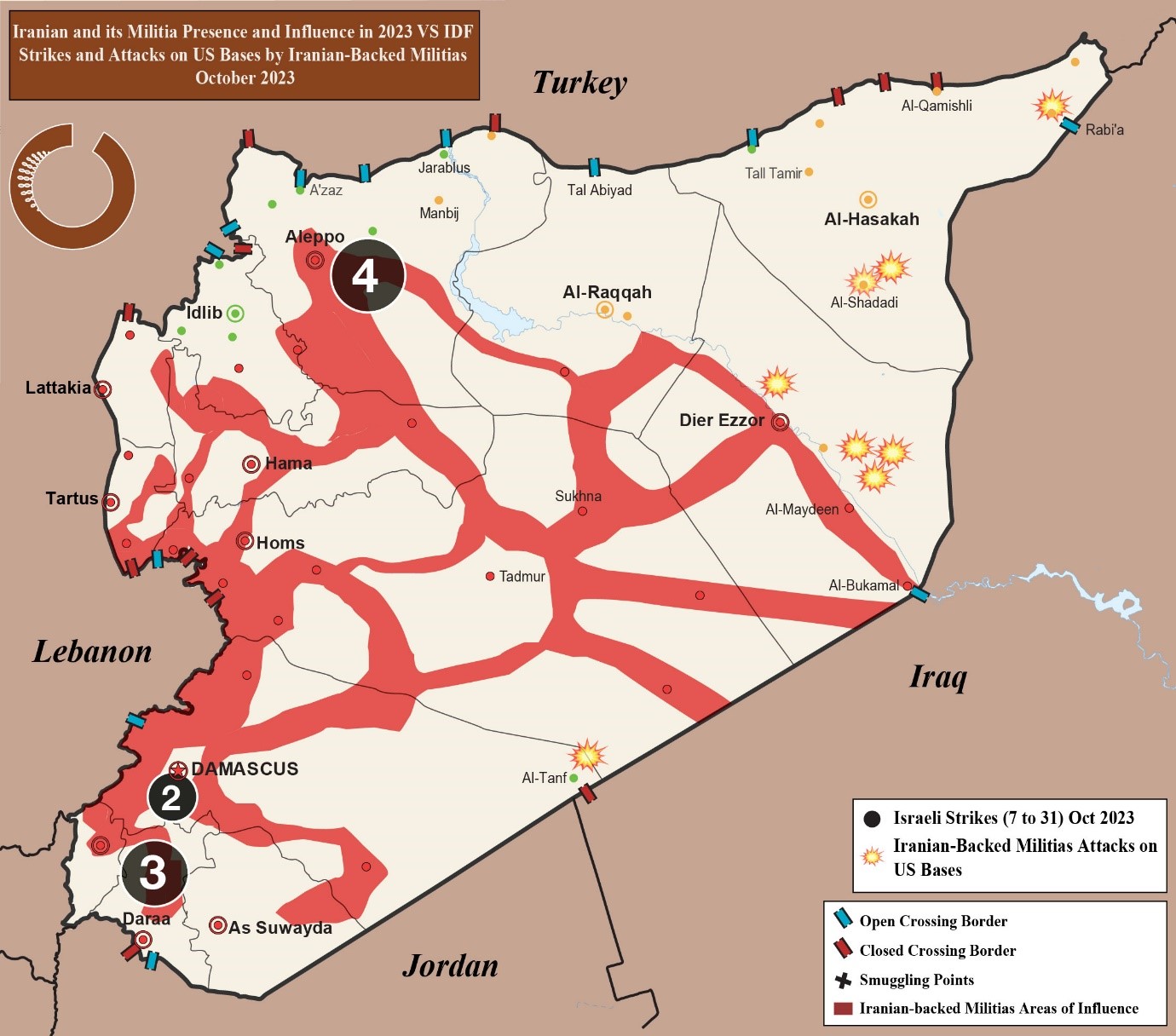
In another development, the military college in Homs city was attacked by unidentified drones, according to regime media, resulting in the deaths of dozens, including officers. This attack is notable for several reasons:
- Ten officers were killed, including two with the rank of brigadier.
- The human toll was significant, with /123/ people killed.
- This attack is viewed as a major security breach, as it targeted a location known for its high level of security.
The attack on the military college led the regime, with Russian support, to launch airstrikes and heavy artillery bombardments on over /30/ locations in Northwest Syria, blaming what they labeled as “Terrorist Organizations” for the attack. This resulted in the deaths and injuries of dozens, including /14/ children, /12/ women, and /38/ men.The regime aimed to use this incident to:
- Strengthen its narrative against revolutionary forces and the opposition.
- Advance its military position on the ground.
- Disrupt the stagnant political process.
- Gain sympathy from Arab and foreign countries to support the regime and condemn the attackers.
- Distract Arab countries from their initiative demanding concessions from the regime on various issues.
In the SDF Held-Areas
Following the “PKK's” claim of responsibility for the Ankara attack near the Turkish Ministry of Interior on the 1st of October 2023, the Turkish Armed Forces launched a series of airstrikes and security operations targeting “SDF”, military bases, and vital facilities in northeast Syria, the technical aspect of this operation signifies a shift in the Turkish military strategy and goals:
- Expanding the geographical scope of targets to locations about 70 km from the Turkish border.
- Targeting infrastructure like oil facilities and electricity generation and distribution stations.
- Striking weapon depots, training camps, and buildings of civil institutions affiliated with the Autonomous Administration.
- Targeting leaders and members of the “Asayish” internal security forces.
- Set new conflict and engagement rules and pressure the US to reconsider its alliance with the SDF in northeast Syria, considering Turkey's security concerns.
Echoes of Gaza in Syria, Civil Unrest in As-Suwayda, and Deir Ezzor's Quest for Calm
The Israeli aggression on Gaza affected the political environment in the region and had a direct impact on the Syrian file. During a UN Security Council session, U.S. Ambassador “Linda Thomas-Greenfield” noted that the events in Gaza are:
- Extension of Iran's security and military increasing role and Hezbollah's militia in Syria.
- Resolving the Gaza and Syria situations starts with stopping the expansion of these militias.
Syrian National Coalition “SNC”
The French FM “Catherine Colonna” canceled a meeting with the “SNC” delegation, which had traveled to Paris to urge French officials to hold a Security Council session and take necessary actions to stop the Regime military escalation in Northwest Syria.
The “SNC” met with Turkish FM “Hakan Fidan”, focusing primarily on economic demands and the need to empower the Syrian Interim Government to provide basic services to the people.
Syrian Regime
The Saudi FM contacted the Syrian regime's FM to discuss regional developments and bilateral relations. “Bashar al-Assad” also met with the Iranian FM in Damascus to discuss the Israeli aggression on Gaza. The regime appointed an ambassador to Tunisia, aiming to enhance its effectiveness in regional and international forums.
In the Southern region, at As-Suwayda Governorate:
- Civilians continued to protest against the regime's indifferent approach and its refusal to make concessions, despite being unable to provide services and funds to the province.
- The Ministry of Local Administration offered a (Gant) of /300/ million SYP, equivalent to about /24,000/ USD.
- Tribes in Daraa and as-Suwayda formed a unified council to unite the efforts of the tribes in both governorates, enhance communication, resolve disputes, and prevent external attempts to create a similar council.
Syrian Democratic Forces
The Autonomous Administration in Northeast Syria and the Deir Ezzor Civil Council held a conference to involve the people of Deir Ezzor in decision-making and address public discontent in the governorate. The conference included various community segments, administration employees, and local leaders from Deir Ezzor. The conference concluded with recommendations to:
- Enable real participation of the locals.
- Build a robust administrative structure based on genuine competencies.
- Strengthen the military security force.
Economic Crisis Deepens: Struggling Against Corruption and Insignificant Reforms
In the Regime Held-Areas
The Supreme Council for Economic and Social Planning has set the 2024 budget for Syria at /35,500/ billion SYP. This is 114% more than last year but 27% less than in 2022 when converted to USD. This budget is unlikely to help the economy grow and will probably cause more inflation and reduce the value of the Syrian lira.
The Central Bank has set the official exchange rate of the Syrian lira to the USD at /12,500/ SYP, close to the black-market rate /13,900/ SYP. Since the start of the year, the Central Bank was and still trying to close the gap between the official and the black-market rates, to encourage people to use the official rate to help increase foreign currency reserves.
Despite the rising cost of living, the Regime government kept on exporting a lot of vegetables and fruits, mainly to Saudi Arabia. This has led to higher prices locally because of reduced supply and increased costs for things like fuel, seeds, transport, and labor. This approach shows a lack of concern for the citizens' living standards and seems to favor the interests of businesspeople and profit over everything else.
In the SDF Held-Areas
Attempts by the administration to regulate the markets and money movements have met with objections from traders. After the Autonomous Administration issued a circular reminding of the necessity to obtain the necessary licenses to engage in currency exchange and financial remittances, set minimum capital clauses, and deposit money with the Monetary Office
The Corruption in within the Autonomous Administration continues to undermine the development of the region and puts pressure on the livelihood of the population, notable incidents:
- Dozens of farmers have complained about not receiving their dues for the crops supplied about 3 months ago.
- Administration employees have complained about delayed salaries due to the alleged lack of budget amidst the difficult economic conditions experienced by the residents of the region in general.
- Teachers complained about having to pay more than 30% of their salary to pay for electricity (amperes), water, and the internet.
- The wages for farming have risen from /7,000/ SYP to /28,000/ SYP per dunum, excluding other expenses, turning agricultural activity into a losing process. This leads to farmers abandoning their agricultural lands.
- RCELL company increased the prices of internet packages by about 400%. The company enjoys broad support from the “Autonomous Administration”.
In the Opposition Held-Areas
Idlib witnessed the opening of its first textile factory, this development might inspire other entrepreneurs to establish similar factories in the area. Additionally, the city hosted the (Idlib Markets 2023) exhibition, featuring numerous new companies and stores. This event is significant for several reasons:
- It allows direct sales to consumers, making essential items more affordable for locals.
- It fosters healthy competition among businesses, leading to discounts ranging from 30% to 40%.
In North Aleppo, the Syrian-Turkish Electricity Company has reduced electricity rates to /2.77/ TL for residential use and /3.17/ TL for industrial and commercial use in Jarablus, Afrin, Azaz, and surrounding regions.
Efforts to revive the economy continue, with local councils and organizations collaborating on infrastructure projects like road repairs, water, and sewage pipe installations, and extending electricity networks. To regulate local affairs, several directives have been issued:
- Health organizations in Jarablus must get official approval before announcing job openings on social media.
- Private educational institutions must secure licenses from the Directorate of Education.
However, the agricultural sector in Ras al-Ain is experiencing difficulties. The interim government is grappling with several issues:
- Preventing large local traders from pressuring cotton farmers into selling their crops at prices that are too low to cover the costs of production, resulting in financial losses.
- The challenge of stabilizing cotton prices, which currently vary between /500/ and /550/ USD per ton, a significant drop from the previous year's range of /750/ to /800/ USD.
- The issue of low wages for agricultural workers, which remain capped at a maximum of two dollars per day.
Monthly Briefing on the Events of the Syrian Scene - September 2023
General Summary
This report provides an overview of the key events in Syria during the month of September 2023, focusing on political, security, and economic developments. It examines the developments at different levels.
- Politically, the Arab initiative involving the Syrian Regime has stalled due to ongoing drug smuggling from Syria to neighboring countries, unresolved refugee issues, and the regime's unresponsiveness to calls for supporting the political process.
- Militarily, persistent security tensions and clashes have unfolded in Deir Ezzor between tribal fighters and the Syrian Democratic Forces “SDF”. Meanwhile, Hasakah experienced several days of conflict between regime forces and the National Defense Forces “NDF”. Additionally, armed conflicts have erupted between opposition factions and “Hay'at Tahrir al-Sham” in Aleppo's countryside.
- Economically, Bashar al-Assad's trip to China failed to secure tangible economic benefits, with the visit merely concluding with the signing of protocol agreements, such as a Syrian-Chinese strategic cooperation pact.
Regime Strategies: Escaping Liabilities and Pursuing Alternatives
Civilian protests persist in As-Suwayda and its outskirts for a second month without expanding geographically, while the regime refrains from intervening as long as the movement remains local and limited. The protests intent on distinguishing between the state and the regime, emphasizing the necessity to maintain basic services, with ongoing demands to establish an economic crossing with Jordan to improve the local economy. Diplomatically, the ongoing protests has redirected attention to the Syrian issue, facilitating opposition diplomatic meetings and garnering international support for Sheikh Hikmat al-Hijri. However, the future political transition in Syria remains uncertain despite the diplomatic efforts and UN envoy “Geir Pedersen's” repeated visits to rejuvenate the constitutional committee.
Officials from various Arab nations have expressed their discontent with the regime’s ineffectiveness in ensuring the Arabic initiative's success, especially due to:
- Ongoing drug flow from the southern border of Syria.
- The unresolved refugee return issue.
- Syrian regime's lack of support for the political process.
Bashar al-Assad's visit to China, his first in 19 years, does not appear to have a tangible impact on political and economic agendas in the near term, aside from media narratives. The pro-regime media have framed the visit as a pursuit of economic alternatives, hinting at impending economic agreements and substantial Chinese projects.
Shifts Within Different Areas of Influence and Control
In the Regime held-areas, The Syrian regime has persistently dismantled military and security checkpoints across various regions, including the southern fronts, aligning with its policy to curtail military and security visibility. However, the Fourth Division, under Maher al-Assad's leadership, has refused removing its checkpoints in the south, like its refusal in the eastern Qalamoun region, attributed to the economic leverage gained through enforcing royalties and overseeing the drug trade.
The Jordanian Air Force conducted two strikes on a drug trafficking location in southern As-Suwayda in response to escalating threats from ongoing drug smuggling operations. Recently, the smuggling activities have posed heightened threats to Jordan, especially after incorporating advanced equipment like drones. The Jordanian border forces reported that they successfully neutralized two drones, utilized by smugglers, during September.
Armed clashes erupted in the city of al-Hasakah, lasting several days, between the regime forces and the NDF militia, led by Abdul Qader Hamo. The conflict resulted in Hamo's death and injuries to dozens of civilians. The regime declared the security operation over after its forces seized the building where the NDF was holed up.
Hamo, dubbed the “King of the Captagon” in Hasakah, appeared in a pre-death video, criticizing “Ali Mamlouk” and the “Baath Party” leadership, accusing them of corruption and demanding large sums of money to settle his situation.
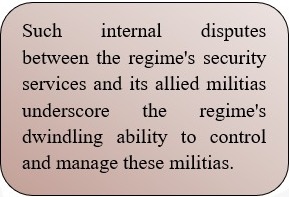
In the SDF held-areas, Armed clashes persisted between certain Arab tribes and SDF forces in Deir Ezzor, even after the SDF declared an end to the “Rebellion” and seized control of Dhiban, home to Sheikh al-Akidat Ibrahim al-Hafil. Al-Hafil, along with some of his fighters, managed to relocate to different areas. The recent tribal uprising highlighted the frailty of the Autonomous Administration's governance and the disconnect between communities and the administration purporting to represent them.While current maps of influence and control appear stable, numerous signs suggest potential future shifts in the security and military landscape, especially with the growing influence of militias allied with Iran and the Assad regime in northeastern Syria.
During September, TSK drones conducted several strikes, targeting and killing SDF leaders, including “Haval Aslan”, leader of the Asayish forces in al-Qamishli, and “Ayman Jolie”, a commander of the Asayish forces in the Jazira region.
In the Opposition held-areas, in Northwest Syria witnessed military skirmishes between the Second Corps, spearheaded by the Sultan Murad Division, and groups affiliated with Hay'at Tahrir al-Sham, including “Ahrar Olan” and “al-Shahba Gathering.” The conflict centered around control of the strategic “Hamran” crossing, utilized for oil smuggling between the eastern and western Euphrates. These clashes are embedded within the war economy dynamics, where such crossings serve as a vital economic resource for the factions.
Economic Problems Multiply, Solutions Yet to be Found
Syrian Regime
Internationally Relations:
Syrian-Chinese Relations:
The visit of Bashar al-Assad and the accompanying economic delegation to China did not yield any tangible economic results that might rescue his government amidst the suffocating crisis it is experiencing.
- The visit was limited to signing protocol agreements, such as Syrian-Chinese strategic cooperation, and three cooperation documents were signed between the two sides; the first is economic cooperation, the second is for exchange and cooperation in the field of economic development, and the third is a cooperation plan within the Belt and Road framework.
- These agreements express only a desire to cooperate without binding agreements for either party.
It is unexpected that China's role will exceed providing humanitarian support to the regime and its incubator, for several reasons, most importantly:
- The strict American and European sanctions on the regime, which hinder the initiation of any major projects before achieving a political solution.
- The deteriorating security conditions and lack of stability in Regime held-areas reduce China likelihood of contributing to the Belt and Road initiative.
- Lack of an investment environment and laws that protect and encourage foreign investors.
- The fierce competition between Russia and Iran and their current control over wealth and trade routes.
Syrian-Iranian Relations:
- Iran has scheduled a plan to establish an oil refinery with a capacity of /140,000/ barrels per day, alongside the existing refineries in Homs and Baniyas.
- Sanctions on the Syrian and Iranian oil sectors hinder the implementation of oil projects in Syria that could contribute to financing the regime.
Domestic Economy and Prices:
- The regime has raised the prices of domestic and industrial gas cylinders, and this increase is expected to be reflected several times over in the black market.
- Electricity prices have been raised by 200%, which may lead to a general increase in inflation in the coming weeks due to its impact on the costs of raw materials and the final product.
- Syrian markets are experiencing a sharp shortage and price increase in baby milk, despite the arrival of quantities as humanitarian aid.
- Fruit prices have risen by 50% this year due to various reasons such as increased farming costs, fertilizer prices, transportation, labor, and most significantly, diesel, which is sold to farmers at about /18,000/ SYP per liter.
SDF Held-Areas
The “Autonomous Administration of North and East Syria” priced the purchase of cotton at $/800/ per ton without announcing its purchase of the crop, which sparked criticisms from farmers.
Cotton farmers have suffered numerous problems this current season, elevating their loss ratio, with the most prominent issues being:
- A rise in the prices of fuels, fertilizers, and pesticides.
- Crop infestation with pests.
- Difficulty in selling crops outside the areas controlled by the SDF.
- The Autonomous Administration's refusal to purchase the farmers' crops, contrary to the previous seasons.
The “Autonomous Administration” increased the price of a bread bundle by up to 200% just days after improving bread quality in its areas. A bread bundle is now sold for /1,000/ SYP, up from /350/ SYP Lira. This decision comes after a 400% increase in fuel prices. The administration bases its price increase for essential items on:
- Rising production costs and the difference with the sales price.
- The administration's move towards reducing social support quotas under the pretext of implementing public services and infrastructure projects.
Opposition Held-Areas
The “Interim Government's” Ministry of Finance and Economy has inaugurated the inaugural investment conference, partnering with Aleppo University, the Economists' Union, and the 2020IDEA Foundation. The conference is designed to:
- Foster economic growth in liberated areas.
- Enhance living standards and amplify job opportunities.
- Reinstate the inflow of United Nations assistance into northwestern Syria via the Bab al-Hawa border crossing with Turkey, following a suspension exceeding two months.
In the western countryside of Aleppo, local councils shared a “notice,” explaining an agreement with the Energy and Electricity Company to cut the price of household electricity by 30%. This price cut was approved after the Turkish government agreed to financially support the electricity sector for companies that provide electricity to northern Syrian areas. Concurrently, the local council in “Bulbul”, located in the Afrin area, inaugurated a new water station to address the locale's drinking water needs, particularly considering the substantial surge in the area's population.
The “Salvation Government's” Public Telecommunications Institution has refurbished the communications network in “Biret Armanaz” ensuring residents have access to internet and landline services.
Military Field Court: Nullification and a No Change Approach
On September 3, 2023, Bashar al-Assad announced Legislative Decree 32 of 2023(1), which nullified Legislative Decree 109 of 1968 and its subsequent amendments. Which eventually had established the Military Field Court(2). With this new decree, all ongoing cases will be transferred to the military judiciary, where they will be prosecuted under the Penal Code and Military Procedure and its amendments(3).
The Military Field Court was initially set up in the aftermath of the Six-Day War of 1967. Its primary purpose was to address crimes that fell under the jurisdiction of military courts during times of war or military operations. Later, its scope was broadened by Hafez al-Assad through Legislative Decree 32 of 1980, allowing it to hear cases during "internal unrest" and thereby permitting civilians to be tried in this court.
It's crucial to note that this court does not meet basic litigation standards. It did not adhere to the principles and procedures outlined in existing legislation. Furthermore, its rulings, including death sentences, were final and not open to appeal. Death sentences required ratification from the head of state, while other sentences were approved by the Minister of Defense.
Historically, the court has been a tool for suppressing Syrian society. This was evident during the 1980s(4), and became even more pronounced after 2011. The security services frequently referred detainees to this court, where many faced the death penalty. Others were sent to “Sednayah Military Prison”, where they were systematically tortured to death(5) .
Despite the court's abolition, the situation will not change significantly. The security services still hold sway over the assessment and categorization of crimes. Over 100,000 detainees and forcibly disappeared individuals remain in the regime's prisons(6) . This suggests that changing the judicial tool does not necessarily alter the regime's behavior. The core issue lies in the fact that there is a governance defect in the military judiciary as a whole(7) . which is summarized by its connection to the executive authority represented by the Ministry of Defense and the connection of its officers to the security services. Moreover, the court has been a hub for financial extortion against detainees' families, generating millions of dollars through corrupt networks(8) .
Furthermore, the challenge of trying civilians in military courts persists. One of Syria's primary issues is the lack of an independent judiciary, both military and civilian. Bashar al-Assad, as the “President of the Republic,” presides over the Supreme Judicial Council, as per Article 133 of the 2012 Constitution(9).
The decision to abolish the court appears influenced by external pressures rather than domestic concerns. The Assad regime seems to be diverting international attention from human rights issues, state restructuring, and accountability. The regime is likely to continue with symbolic gestures, such as issuing new amnesty decrees, reducing military presence on public roads and dismissal of a number of conscripts and reserve personnel from the army. These actions are seen as superficial attempts to appease the international community amidst the regime's growing isolation and economic crisis.
The court's abolition is also seen as a move to pre-empt international legal actions against the Assad regime for torture crimes. This comes ahead of the “International Court of Justice's” hearings on the lawsuit filed by Canada and the Netherlands against the regime(10). The decision is also linked to the Arab initiative and the step-by-step approach, especially concerning refugees' legal and security concerns.
A significant aspect of this decision is the regime's attempt to distance itself from the Military Field Court's actions, especially since its reactivation in 2011. In accordance with paragraph (a) of Article 8 from the decree that established the court, death sentences required ratification from the head of state. This means every death sentence since 2000 has been directly approved by Bashar al-Assad.
The annulment of the military field court decree doesn't negate it’s on the ground application automatically. It's tied to other procedures, and mere superficial changes at the top aren't sufficient. Resorting to the military judiciary often leads to further repression due to significant loopholes. This judiciary's laws and its consistent use serve as intimidation tools.
The regime's decision to dissolve the court can be attributed to its strategy of handling enforced disappearances and murders. By operating within this exceptional judiciary and indirectly sending detainees to “Sednayah military prison”, this helps the regime circumvent the UN General Assembly (UNGA)’s decision to form an international mechanism to reveal the fate of missing persons in Syria. This move coincides with Canadian and Dutch efforts to hold the regime accountable at the International Court of Justice for violating the convention against Torture, which was ratified by the regime in 2004.
Previously the Assad regime abolished the state of emergency and the State Security Court in 2011(11). By 2012, they introduced the Anti-Terrorism Law and established the “Terrorism Cases Court”(12) . However, these changes didn't alter the regime's oppressive tactics. Instead, they intensified their crackdown through various courts, including military, field, and civilian ones. With the “Military Field Court's” dissolution, its alternative is already in place.
Genuine change in Syria isn't about switching litigation tools. It hinges on three unavailable criteria: judiciary independence, assigning case types to the Attorney General instead of security services, and a shift from emergency law dynamics. The distinction between judicial tools is merely administrative.
Real change in Syria requires a conducive political environment, an independent judiciary, and robust constitutional institutions that enforce the law. Local civil bodies must oversee the change process and safeguard citizens' rights. Without transparency and laws granting access to information, assessing change remains impossible, especially with the regime's secrecy around detainees and the missing.
For legal reform in Syria, two primary requirements stand out: First: abolishing the laws from which security agencies feed. Second: legally curbing the violations of security agencies, especially arbitrary detention, and torture, which are tools to silence and instill fear in citizens, their violations can be curbed through laws combating arbitrary detention in its three types, ensuring the foundations and rules of a fair trial, and combating torture.
In conclusion, the regime’s changing of the sole leadership system will remain symbolic and evasive captive to formalism, blackmail, and evasion, which has been its practice throughout the Baath era. Genuine change requires a political climate that involves all actors. While the regime might present this move (Abolition of the field court) as an extension of the Arab initiative or a political process step, it's likely a superficial response to growing internal unrest, particularly in Suwayda and southern Syria.
Human rights and civil society organizations must critically assess these developments. Political entities should push international players totem pressure the regime and its allies to address the fate of the missing, ensure a safe environment for Syrians' return, and earnestly participate in the political process, with Resolution 2254 at the forefront.
([1]) “Legislative Decree No. 32”, Sana, Publication date: Sep 03, 2023, Link: https://bit.ly/48AmAXB
([2]) “Bashar al-Assad ends the system of military field courts”, The new Arab, Publication date: Sep 03, 2023, Link: https://bit.ly/46i3Jiy
([3]) “The Penal Code and Military Procedure”, The Syrian Parliament, Publication date: Mar 13, 1950, Link: https://bit.ly/3Lh0EUh
([4]) “The Muslim Brotherhood Uprising in Syria (1979-1982) which comprised the Hama massacre”, EUAA, Publication date: September 2020, Link: https://bit.ly/3LKVD9V
([5]) “An Instrument of Death and Disappearance: How the Syrian Regime Uses Military Field Courts Against Activists and Dissidents” SNHR, Publication date: Sep 12, 2023, Link: https://bit.ly/46BuVZ4
([6]) SNHR’s 12th Annual Report on Enforced Disappearance in Syria”, SNHR, Publication date: Aug 30, 2023, Link: https://bit.ly/46z6w6
([7]) “Changing the Security Sector in Syria”, Omran Center for Strategic Studies, Publication date: Oct 23, 2017, Link: https://bit.ly/45jogSp
([8]) “Families of Syrian prisoners and missing persons 'paid $900 million' to find out the fate of their children”, BBC, Publication date: Sep 14, 2023, Link: https://bit.ly/3EZXbJ4
([9]) “Syrian Arab Republic 2012”, Constitute project, Publication date: Feb 27, 2012, Link: https://bit.ly/48Giihe
([10]) Application of the Convention against Torture and Other Cruel, Inhuman or Degrading Treatment or Punishment (Canada and the Netherlands v. Syrian Arab Republic)”, International Court of Justice, Publication date: July 15, 2023, Link: https://bit.ly/45irIwH
([11])“Syria announces lifting of state of emergency and cancellation of Supreme State Security Court”, the world of the homeland, Publication date: Apr 10, 2011, Link: https://bit.ly/3LJUv6l
([12])“Law 22 of 2012 establishes a Damascus-based terrorism case court”, The Syrian Parliament, Publication date: July 26, 1950, Link: https://bit.ly/3RrxSqP
